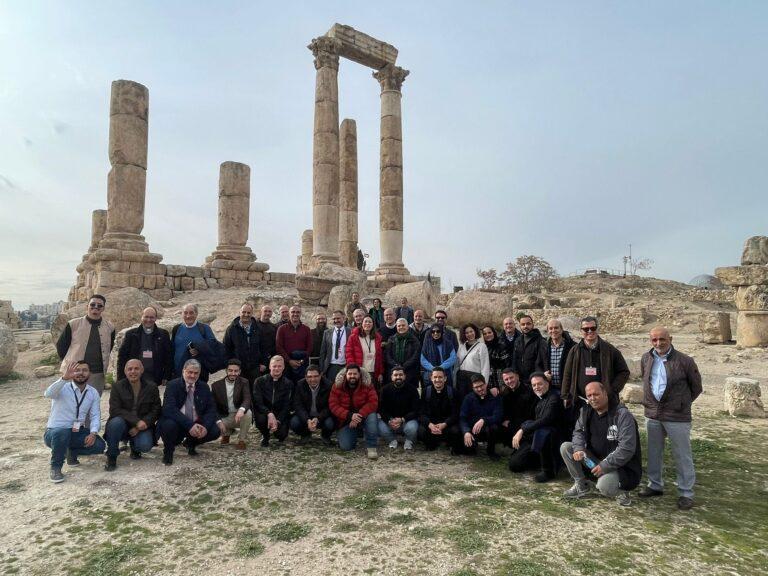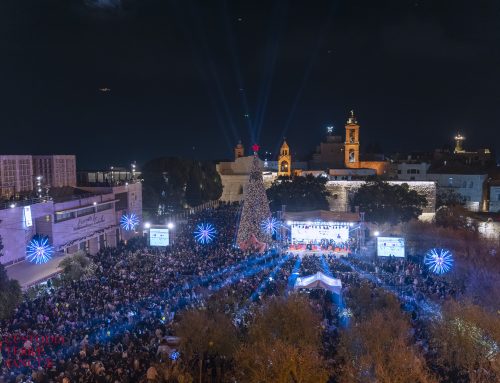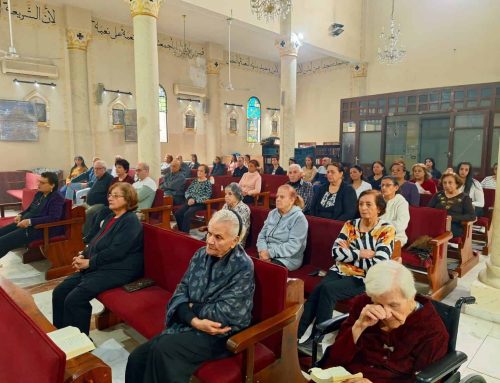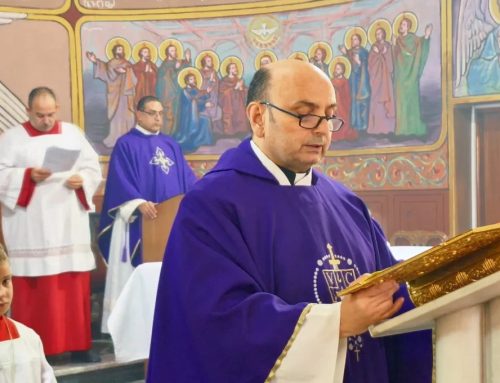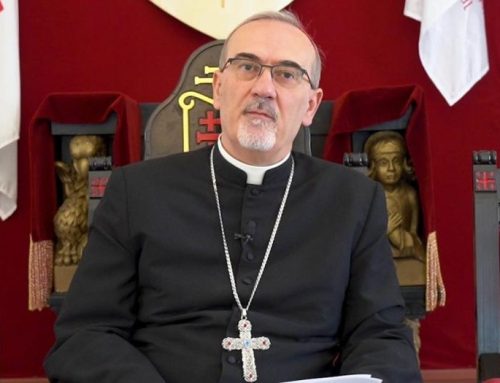Jordan is widely known for sites such as Petra and Jerash—magnificent and monumental archaeological locations famous for the fiery red of their rocks, the desert’s vastness, and the blue sky that frames them. It is famous for the salt of the Dead Sea, for its deep gorges like Wadi Mujib, and for its wild, evocative nature. However, few realize that a journey to Jordan can also become an opportunity for true pilgrimage, discovering places intimately connected to the Holy Land and the roots of Western culture.
Jordan and Christianity
On the banks of the Jordan River lies the site believed—supported by archaeological evidence found in the 1990s—to be where Jesus was baptized. There is also Umm al-Rasas, once home to dozens of churches, some of which still display the splendor of their mosaic-adorned floors. In the Church of Saint Stephen in Madaba, for example, one can admire a stunning mosaic renowned for depicting ancient cities of the region—a masterpiece that Pro Terra Sancta preserves a reproduction of at its headquarters in Milan.
These are just some of the places that narrate the establishment of Christianity in Jordan: Mount Nebo, offering a sweeping view of the Promised Land and preserving the memory of Moses; the lands associated with the biblical figure Ruth; and the hill of Machaerus, near Madaba, where Herod’s palace once stood—a site believed to be the setting of John the Baptist’s execution.
The Workshop Promoted by Pro Terra Sancta
The idea of promoting this prestigious heritage and making it more accessible and appealing to the tourism market lies at the heart of the “In the Footsteps of Christianity in the Holy Land of Jordan” workshop. Over the course of three days, Amman hosted lectures and discussions primarily aimed at local tour guides, offering them training and updates to help develop—and, in fact, create—a new type of tourism focused on pilgrimage and retracing the footsteps of Christians in Jordan.
“We realized that very few people consider Jordan as a destination for Christian pilgrimage,” explains Tommaso Saltini, General Director of Pro Terra Sancta, who opened the first day of the workshop alongside other dignitaries, including the Apostolic Nuncio Giampietro dal Toso (whose address is included at the end of this article). “Jordan is a wonderful place: there is the famous Petra, the desert… But it is also home to many sites connected to the Holy Land, places that recall events and figures from both the Old and New Testaments.”
“One of the most significant activities in the history of Pro Terra Sancta has been the preservation of cultural heritage, carried out in collaboration with the Franciscan Custody of the Holy Land and the Studium Biblicum. We believe that conserving and promoting local cultural heritage not only presents a great opportunity for economic, touristic, and cultural development but also supports education and training. To continue doing so in Jordan today, we must promote the concept of Christian pilgrimage,” he continues.
“This is the first training course designed specifically for guides who wish to deepen their knowledge of Christianity’s history in Jordan,” says Rosario Pierri, Rector of the Studium Biblicum Franciscanum, whose full address is included at the end of this article. Over the three days, classroom lectures were complemented by numerous on-site visits in and around Amman and Madaba, including Mount Nebo, allowing guides to experience firsthand the places that could become key stops in a new wave of tourism in Jordan.
“The tour guides who participated were enthusiastic about the wealth of information they received. They expressed profound gratitude and played a crucial role in the success and impact of this event,” recounts Tareq Rezeqallah, Country Manager of Pro Terra Sancta in Jordan. “We feel we have sent a strong message, demonstrating to the world that the land of Jordan is indeed a Holy Land. A testament to the importance of this message is the fact that this conference coincided with the Vatican exhibition ‘Jordan: The Dawn of Christianity,’ which highlights our country’s crucial role in the history of Christianity.”
The Address of the Apostolic Nuncio in Jordan, Giampietro dal Toso
Dear friends,
I am very pleased with this initiative to train tourist guides in Jordan, to deepen their knowledge of this land as a biblical land. I am grateful to the Pro Terra Sancta Foundation and the Studium Biblicum Franciscanum for organizing this workshop. I would like to mention in a special way Fr. Michele Piccirillo, who did so much for the archeological discoverings in Jordan. Significantly, it is taking place at the same time as the exhibition in the Vatican on Christian Jordan: Jordan, the dawn of Christianity. Let me also thank His Majesty Abdullah II and the Government of Jordan for their attention to the Christian heritage of this country. Fr. Pierri already recalled the great and long attention of the Holy See to Jordan as part of the Holy Land.
To promote religious tourism, it is necessary that tourism does not lose its religious characteristic. My statement is in a certain sense tautological, but it wants to underline that religious tourism can be promoted only if it does not lose its spiritual dimension, which for us in Jordan is fundamentally linked to the Holy Scripture. Here there are many places linked to the Old and New Testaments and visiting them makes biblical knowledge more alive, but also and above makes alive all the experience of grace that transpires from these places. Therefore, I thank the guides who wanted to be present at this training, because they will be helped to introduce pilgrims to this experience of the Spirit precisely during the journey to Jordan. Moreover, even in the context of the Holy Year in which we are living, the pilgrimage acquires a particular meaning, and Pope Francis also recalled this in the Bull of Indiction of the Holy Year. I therefore believe that a catechetical and liturgical dimension of the pilgrimage for Christians cannot be missing.
I conclude with a thought that is particularly close to my heart. Is there a key to theological synthesis for the holy places in Jordan? Many professors present here are better suited than I to give an answer. However, I also dare to make a proposal, and starting precisely from the saint who most marks this country, who is Saint John the Baptist. Edom with Esau and Jacob, Moab with Lot, Balaam and Ruth,
Mount Nebo with Moses, Amman with King David, Tisbe with the prophet Elijah, all speak of an expectation that is fulfilled in John the Baptist, who opens the door to the arrival of Jesus and baptizes him at Maghtas. It is a great story of salvation that culminates in Christ, of which John the Baptist is the door of arrival and passage. The pilgrimage to Jordan could represent through the biblical figures and places a moment to renew our personal expectation of Christ and to remember its fulfillment in our baptism.
I wish everyone, both teachers and listeners, a fruitful workshop. Thank you.
The Address of Rosario Pierri
Your Excellency Giovanni Pietro Dal Toso, Dear and distinguished leaders and representatives of the Jordanian Authorities, Dear friends,
the event we are about to experience today and in the next few days is like a dream come true. It was time for Jordan to claim more vigorously its status of Holy Land, as a constitutive part of the land in which some prophets, Jesus of Nazareth, his apostles and his disciples journeyed. The latter, historically, had been preceded by Saint John the Baptist who, on the banks of the Jordan, as the Gospels tell us, was baptizing those coming to him to confess their sins.
Jordan keeps the remains of a tradition that must be valued and promoted with conviction first and foremost for religious reasons, but also to spread awareness on its rich historical, archaeological and artistic heritage.
This “dream” is gradually coming to life and today, thanks to the commitment of the Apostolic Nuncio to Jordan, His Excellency Giovanni Pietro Dal Toso, and of Doctor Sara Cibin, representative of Pro Terra Santa Association in Jordan, and to the collaboration of professor Gianantonio Urbani (SBF), we are gathered here to begin the first Training Course intended for pilgrimage guides who aspire to delve deeper into the history of Christianity in Jordan: “In the Footsteps of Christianity in the Holy Land of Jordan”.
Many events have long prepared the revival of Jordan as a center of Christian pilgrimage, an enlightened choice of the Royal House and the Government of Jordan.
The pilgrimages of the Supreme Pontiffs to the Holy Land have played a fundamental role in this great project. For the Popes, this pilgrimage is conceived as a sort of return to the land of the origins. This was the case for Pope Paul VI (the sixth) who, shortly before flying to the Holy Land, declared: “And in fact, our journey is intended to be a return to the cradle of Christianity, where the mustard seed of the evangelical parable put down its first roots, spreading like a leafy tree, which now covers the whole world with its shadow.” The Holy Land is the land of the “Mysteries of redemption”, of the “places made holy by the Life, Passion and Resurrection of Our Lord”.
The idea of the return emerges in explicit words in John Paul II’s (the second’s) greeting to the King of Jordan, His Majesty ‘Abd Allāh II (the second), and to the members of the Government (20th March 2000): “My visit to your country and the entire journey which I am beginning today is part of the religious Jubilee Pilgrimage which I am making to commemorate the Two Thousandth Anniversary of the Birth of Jesus Christ. From the beginning of my ministry as Bishop of Rome, I have had a great desire to mark this event by praying in some of the places linked to salvation history …, places where our Lord Jesus Christ actually lived, or which are connected with his work of redemption.”
Benedict XVI (the sixteenth) reveals the profound intention of his pilgrimage to the Holy Land in his speech at the Regina Pacis Center in Amman (8th May 2009). The Pope considers himself one of the many pilgrims who have felt the need to visit the Holy Land: “Like countless pilgrims before me it is now my turn to satisfy that profound wish to touch, to draw solace from and to venerate the places where Jesus lived, the places which were made holy by his presence.” Like his predecessors, Benedict XVI (the sixteenth) was deeply concerned by the continuing tensions across the world that undermine peace.
On the 24th May 2014, Pope Francis addressed the Jordanian authorities upon his arrival in Amman as follows: “Your Majesties, Excellencies, Dear Brother Bishops, Dear Friends, I thank God for granting me this opportunity to visit the Hashemite Kingdom of Jordan in the footsteps of my predecessors Paul VI (the sixth), John Paul II (the second) and Benedict XVI (the sixteenth). I am grateful to His Majesty King Abdullah II (the second) for his warm words of welcome, as I recall with pleasure our recent meeting in the Vatican. I also greet the members of the Royal Family, the government and the people of Jordan, this land so rich in history and with such great religious significance for Judaism, Christianity and Islam… I take this opportunity to reiterate my profound respect and esteem for the Muslim community and my appreciation for the leadership of His Majesty the King in promoting a better understanding of the virtues taught by Islam and a climate of serene coexistence between the faithful of the different religions. You are known as a man of peace and a peacemaker: thank you! I am grateful that Jordan has supported a number of important initiatives aimed at advancing interreligious dialogue and understanding between Jews, Christians and Muslims. I think in particular of the “Amman Message” and the support given within the United Nations Organization to the annual celebration of “World Interfaith Harmony Week.” … Finally, I cordially invoke peace and prosperity upon the Kingdom of Jordan and its people. I pray that my visit will help to advance and strengthen good and cordial relations between Christians and Muslims.”
All four distinguished pilgrims visited the Holy Land with the aim of drawing new life for their ministry and to promote peace based on justice. They felt a uniting bond with the pilgrims who preceded them and like them, they prayed in the holy places, presenting the needs of the church and the world to Christ.
Despite its glaring contradictions, the Holy Land will always remain the land of Jesus and of God’s revelation. The attention of the Popes and in general, of Christians of every confession towards this land, is an essential element of faith on a historical and theological level.
The foundation stone of the ‘Church of the Baptism of Jesus’ al-Maghtas was laid by Benedict XVI (the sixteenth) on the 10th May 2009, during his pilgrimage to the Holy Land. Last January 10th (2025), His Eminence Cardinal Pietro Parolin, Secretary of State of the Vatican, on behalf of Pope Francis, presided over the rite of consecration of the Church. From an ecumenical perspective, the place had been rediscovered by the Franciscan Father Michele Piccirillo.
To understand how we came to this Training Course today, we need to go back in time, to the period preceding the Jubilee of 2000. Father Piccirillo himself recounts us some notable facts of this story.
As the year 2000 was approaching, a project long desired by His Majesty King Hussein, to make the traditional place of Jesus’ baptism accessible in Jordan, came back to the fore. The opportunity to reach the site happened in 1995, when Father Michele Piccirillo was involved by Prince Ghazi Ben Muhammad, nephew of King Hussein, in a publication dedicated to the Muslim and Christian sanctuaries of Jordan.
On August 11th of that year, escorted by soldiers, they went to Wadi Gharaba, from there they headed north until they reached the plain of er-Ramah and Kafrein, where they found few remains of walls. After a brief stop to refresh at the headquarters of the local military command, the colonel of the military contingent personally guided the renowned guests to the amphitheater of which the Prince and Piccirillo had already caught a glimpse before. On a slight elevation in the ground, they found mosaic tiles and shards of Roman and Byzantine ceramics. Prince Ghazi became very enthusiastic and asked Piccirillo: “When do we start the excavation?”.
At first, the thought was to create a park to protect the valley and to build a Muslim sanctuary (a magam) for Yahya, the Baptist of the Quran, and a small church to welcome Christian pilgrims.
On the 10th September 1997, King Hussein with a decree, established a “royal commission for the development of the park of the baptism of the Lord the Messiah (upon him be peace) in the Jordan Valley”. The commission was chaired by Prince Hassan Ben Talal. Other prominent members of the commission were Prince Ghazi Ben Muhammad and several Jordanian government ministers. The first meeting of the commission took place on the 11th November 1997. That date opened a new era of the history of the Baptism site, which culminated in the consecration of the splendid church on January 10th of this year.
I have presented to you, dear friends, this short story to give you the idea of how a large tree grew from a small seed, destined to rise even further and bear many good fruits for everyone, for pilgrims and for the local population. By now the project has extended to a whole series of places scattered across Jordanian territory from north to south, and we are all very happy about it.
Finally, I would like to mention with great pleasure the ongoing exhibition entitled “Jordan: the dawn of Christianity”, being held in the Vatican from the 31st January to the 28th February and promoted by the Ministry of Tourism and Antiquities of Jordan. Some of you present here, allow me this addition, certainly remember the numerous exhibitions organized in important cities of the world by the late father Michele Piccirillo, who was able to transform the magnificent mosaics found in many sites into true ambassadors of Jordan in the past and today, always enjoying great success and managing to create an admirable symbiosis between history, faiths and peoples.
Our Training Course for Guides is also intended to be a small seed planted in a vast field. In the eyes of some, perhaps, it may appear to be an unimportant event, but this is not the case, because we humbly place this activity of ours before God. He will know how to make it grow and become fruitful.
On behalf of the Studium Biblicum Franciscanum and the other organizers of the Course, thank you for coming. The good number of subscribers is a good sign. It means that we are on the right path. I wish to you all a good and fruitful experience.
By:proterrasancta
source link: https://www.proterrasancta.org/en/news/following-the-roots-in-jordan

